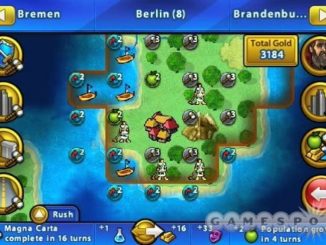
Western games have peaked in the last decade, with each new franchise revolutionizing graphics, gameplay, and bringing the world of gaming closer to cinema. Games like Halo, Gears of War, Call of Duty, and Skyrim have opened doors to possibilities that I could never have imagined as a gamer growing up. But, there are times when I reminisce the days of ZELDA, Secrets of Mana, and Dragon Warrior, times when I wonder where all the quirky Japanese titles have gone – times when I’m glad for games like Legasista. This title serves as a reminder of a genre that shaped the industry, a trip down memory lane to fundamental gaming elements that bred life to video games we know today. What you’ll notice right away is the Japanese charm that envelops Legasista, a nostalgic nod to 90’s gaming humor and an artistic style that anyone who’s ever played old school RPGs will immediately embrace.
The Good
– Fantastic throwback to old school dungeon crawling
– Charming style
– Equipment and item management is exceptionally strategic
– Soundtrack is catchy
The Bad
– Visuals, while charming, could use more variety and detail
– May be too old school for some gamers
Legasista takes place in a futuristic world where knowledge and science are myths of the past; they’re seen as curses and witchery. You play as the Sonic-haired Alto who sets out on a journey to discover hidden secrets of the mysterious Ivy Tower, a palace housing ancient relics of the lost art of science. His sister Mari is captured in a crystal-like object and Alto believes the tower holds answers that’ll break the crystal’s curse. You meet hilariously bizarre characters on your travels, like the cyborg-guardian girl who goes by the name, ehm, Ms. Dungeon, or the talking bean sprout that continually proposes to you – yea, that’s right… a talking bean sprout is in love with you.
Legasista is a dungeon crawler at its core, but the gameplay has a bit of a learning curve. You’ll spend the first 10+ levels playing through tutorials that slowly introduce new gameplay mechanics. It’s never too overwhelming, but to succeed, you need a good deal of strategy and equipment optimization skills. When you’re not fighting inside dungeons, you find yourself in a place called the Railyard. This is Ms. Dungeon’s home base and your place to upgrade and equip various weapons.
Dungeons in Legasista are randomly generated, so you’re never crossing the same layout. If you die, or choose to retreat, you return to a completely new level terrain, which keeps things exciting and challenging throughout. Legasista resembles Nintendo’s 8-bit ZELDA at first, but you quickly discover that navigating the cutesy dungeons is not as easy as it sounds. Battles become increasingly challenging early on and every minor tweak to your equipment counts. When striking enemies, your HP (hit points) and durability gauges deplete, and if they both reach zero, you’re carried back to the Railyard by one of the talking beans, losing all equipment found in the level. (You also gain only half the EXP). It’s imperative to keep the durability of your weapons and armor in check, because if they break, you lose the benefit from its effects. You don’t get penalized for losing HP, but of course you die if it hits zero – however, reaching zero on your durability bar doesn’t kill you, but makes your equipment unusable until repaired. Returning to the Railyard refills all gauges back to 100%.
You can find valuable items in dungeons, but you have to keep them safe until you return to the Railyard to repair them, otherwise they’re gone for good. You also find items with golden writing, meaning they’re not broken and you’re able to equip them right away. BUT, using these weapons before taking them to the Railyard means they’re lost forever if they break. Your best bet is to take everything back in order to ensure it’s ready for battle. You can apply found objects to your equipment for performance boosts and such and you’ll spend a good deal of time upgrading and equipping the most effective armor/weapon sets before venturing out.
In dungeons, your single-use items (like the edible bean sprouts) deteriorate as you advance through floors, so it’s important to strategically implement your inventory. Lanterns are particularly precious when venturing the dark corridors. Equipping a lantern zooms out the camera and lights up the area so you get a better overview of upcoming enemies – but beware, lanterns have limited fuel, so use them sparingly. Every dungeon is filled with a ton of traps: poison gas, spikes, fireballs, explosions, you name it. Dodging traps while fighting quick-moving foes is tricky, but if you’re savvy enough, you can use traps for counter attacks. Combat is smooth and precise, but because of the traditional top-down view and grid-like movement, the d-pad functions much better than the analog stick.
It doesn’t take too long before the dungeons become more colossal and complex. Yes, it’s quite possible to get lost if you’re not paying attention, but it never feels unfair. Sometimes you’re required to flip several switches to open a door, and they are oftentimes scattered throughout the entire level. Certain enemies will drop bronze keys that unlock special areas with tougher enemies and rare collectibles, but since you can’t predict the dangers lurking ahead, it’s wise to proceed with great caution.
Soon you’ll have a party that consists of up to three members, but only one can be active at a time. You’re able to switch back and forth between them in the midst of combat by flinging the right analog stick up and down – strange, I know. Secondary characters can have advantageous traits, like poison immunity and such, so switching back and forth instantaneously can help your assisting character recover from certain damages. Since the supporting characters can’t attack, you can use their magic commands to help your active member. You frequently encounter mini bosses that hold keys and they can be quite brutal. Several regular enemy-types and dozens of traps usually surround them. Considering their massive size and oftentimes-small rooms, things can get uncomfortably hectic. What makes Legasista so great is that you’re given considerable upgrade choices, so you’re never unfairly overpowered. There is a crazy amount of loot and you find yourself checking stats every single time you exit a dungeon. Everything works quickly, so it never feels like a chore. What’s also unique is that you’re upgrading your heroes through weapons rather your typical leveling up of character stats. Once you have a general grasp of the menu system, it’s easy to pick the best available equipment, without driving yourself crazy.
Legasista is a massive game, with some dungeon floors reaching triple digits. The combat is surprisingly diverse and challenging, and there’s even a character creator that let’s you shape endless, bizarre-looking, anime-warriors for your party. It’s a rare little title that shouldn’t be overlooked because of its simple premise. Behind the simplistic, old-fashioned RPG influence, lays a complex dungeon crawler that I recommend to anyone with an itch for gaming nostalgia.
Review by Tin Salamunic
FINAL SCORE
“A homage to old school RPGs” (8.5)
GRAPHICS
Very charming and absolutely adorable, but could use more variety in the environments. It looks very much like a SNES game with HD graphics. (6.5)
GAMEPLAY
Incredibly addictive combat system that’s surprisingly challenging and requires a good deal of strategy. A great showcase of why the genre garnered so much success. (8.0)
VALUE
Massive, varied, and thoroughly entertaining. The randomly generated dungeons are a great way of keeping the levels fresh. (8.5)
SOUND
Catchy tunes and authentic Japanese voice acting. The intro song is a real tease and I wish there were more songs like it during gameplay. (8.0)
Proudly WWW.PONIREVO.COM



